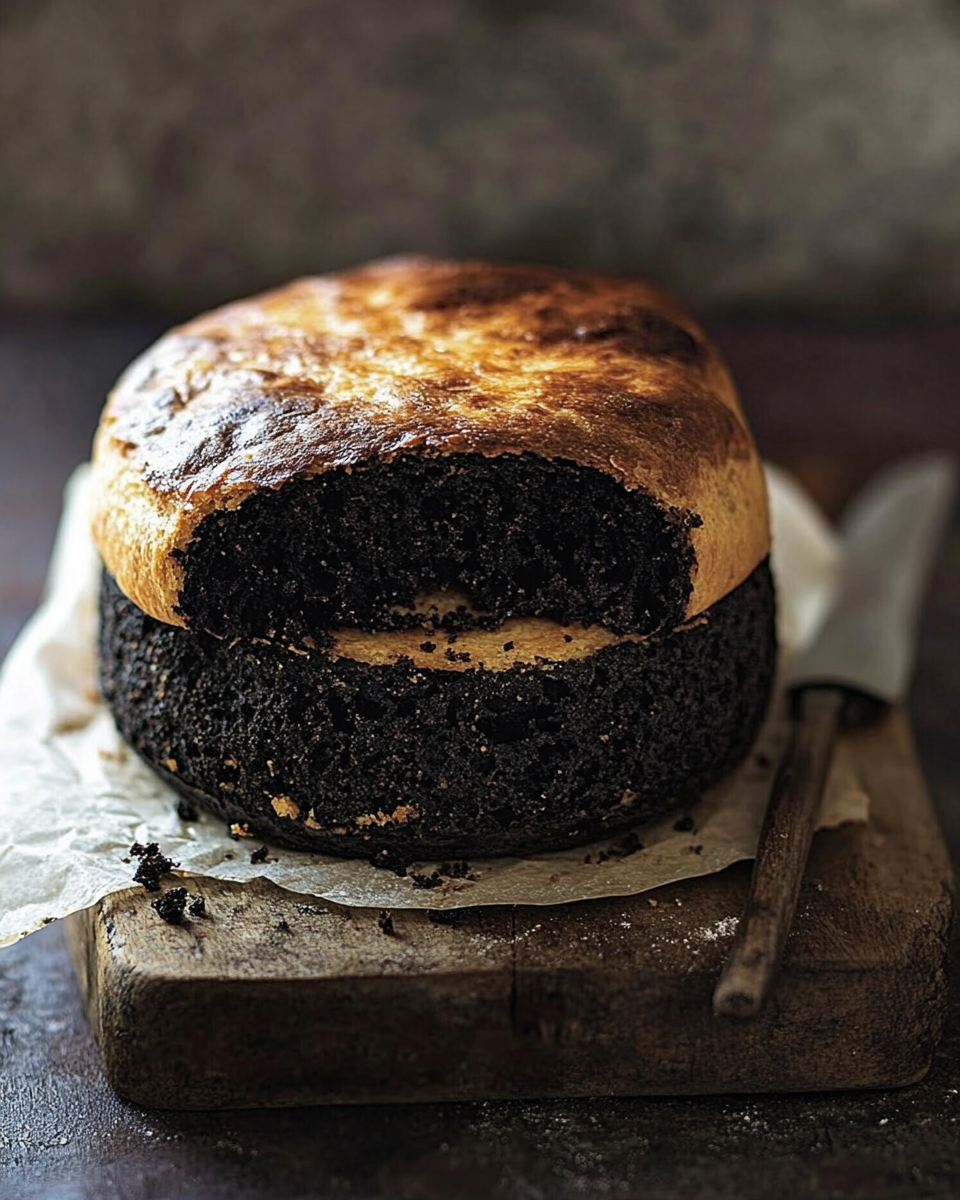Scottish Black Bun is a rich and dense fruitcake enclosed in a crisp, buttery pastry, making it a unique and traditional treat for Hogmanay celebrations. Packed with warm spices, nuts, and dried fruit, and infused with a touch of whisky, this dessert is a festive delight that has been enjoyed in Scotland for centuries. The pastry seals in all the flavors, allowing the fruit and spices to meld beautifully over time, making it even more flavorful as it rests. Perfectly paired with a cup of tea or a dram of whisky, Black Bun is a show-stopping centerpiece for any festive table. Its deep, complex flavors and crumbly pastry contrast wonderfully, creating a dessert that is both indulgent and steeped in history. Whether you’re continuing a Scottish tradition or trying something new, this Black Bun is a must-try for any holiday feast.
Full recipe:
Ingredients:
For the Pastry:
- 300g (2 ½ cups) plain flour
- 150g (⅔ cup) unsalted butter, chilled and cubed
- 50g (¼ cup) caster sugar
- 1 egg yolk
- 3-4 tbsp cold water
For the Filling:
- 350g (2 ⅓ cups) mixed dried fruit (raisins, currants, sultanas)
- 100g (½ cup) dark muscovado sugar
- 1 tsp ground cinnamon
- 1 tsp ground ginger
- ½ tsp ground allspice
- ½ tsp ground nutmeg
- 50g (⅓ cup) chopped almonds
- 50g (⅓ cup) chopped walnuts
- 50g (⅓ cup) candied peel, chopped
- 2 tbsp black treacle
- 2 tbsp whisky
- 1 egg, beaten (for sealing and glazing)
Directions:
-
Prepare the Pastry:
- In a large bowl, rub the butter into the flour until the mixture resembles fine breadcrumbs.
- Stir in the sugar, then add the egg yolk and enough cold water to form a firm dough.
- Wrap the dough in cling film and chill for 30 minutes.
-
Prepare the Filling:
- In a large bowl, combine the dried fruit, sugar, spices, nuts, and candied peel.
- Stir in the black treacle and whisky until well combined.
-
Assemble the Black Bun:
- Preheat the oven to 180°C (350°F).
- Roll out two-thirds of the pastry on a lightly floured surface and use it to line a greased loaf tin.
- Spoon in the fruit mixture, pressing it down firmly.
- Roll out the remaining pastry to form a lid, brush the edges with beaten egg, and seal the pastry over the filling.
- Brush the top with more beaten egg and pierce with a fork to allow steam to escape.
-
Bake:
- Bake for 1 hour, then reduce the oven temperature to 160°C (320°F) and bake for another 30 minutes until golden brown.
- Allow to cool completely before slicing.
Prep Time: 30 minutes | Cooking Time: 1 hour 30 minutes | Total Time: 2 hours
Kcal: 380 kcal per slice | Servings: 8-10 slices
Scottish Black Bun: A Traditional Hogmanay Delicacy with Rich History and Flavor
Introduction
Scottish cuisine is known for its rich history and deep-rooted traditions, and Scottish Black Bun is a perfect example of this. A staple during Hogmanay celebrations (Scottish New Year’s Eve), Black Bun is a dense, spiced fruitcake wrapped in a crisp pastry shell, creating a uniquely satisfying and festive treat. It is often enjoyed with a glass of whisky or tea, making it a perfect holiday indulgence.
Unlike traditional fruitcakes that are aged for weeks, Black Bun is baked with a pastry crust, which locks in all the flavors, keeping it moist and delicious for longer periods. This cake is not only a culinary delight but also a piece of Scottish history that carries cultural significance.
In this article, we’ll explore the origins of Black Bun, its benefits, why it’s the best festive fruitcake, and why you should add it to your holiday traditions.
The History of Scottish Black Bun
Black Bun has a fascinating history dating back to the 16th century. Originally, it was called “Twelfth Night Cake”, as it was traditionally eaten on the Twelfth Night (January 5th) celebrations. However, with the decline of Twelfth Night festivities, the tradition shifted to Hogmanay, making Black Bun the ultimate Scottish New Year’s treat.
It is believed that the term “Black Bun” originated in the 19th century, and it became widely popular after it was mentioned in Sir Walter Scott’s 1816 novel, “Old Mortality”. The novel describes how the cake was an essential part of Scottish hospitality, often gifted to visitors and neighbors to symbolize good fortune and prosperity for the new year.
Even today, many Scottish families prepare and share Black Bun during Hogmanay, making it an important part of the cultural heritage. The combination of spices, dried fruit, whisky, and pastry represents warmth, generosity, and celebration, which aligns perfectly with the festive season.
Why This Recipe is Special
1. A Unique Twist on Fruitcake
Unlike traditional fruitcakes, which are often soaked in alcohol and stored for months, Black Bun is baked inside a crisp pastry shell, creating an exciting contrast of textures. The pastry prevents the cake from drying out while allowing the flavors of the fruits, nuts, and spices to meld beautifully.
2. Rich in Nutrients and Natural Energy
This cake is packed with nutrient-dense ingredients such as:
- Dried Fruits (raisins, currants, sultanas) – A great source of natural sugars, fiber, and antioxidants.
- Nuts (almonds, walnuts) – Provide healthy fats, protein, and essential vitamins.
- Spices (cinnamon, nutmeg, allspice, ginger) – Known for their anti-inflammatory and digestion-boosting properties.
3. A Long-Lasting Treat
One of the great things about Black Bun is its long shelf life. Thanks to its dense fruit filling and protective pastry layer, this cake stays fresh for weeks when stored properly. This makes it an ideal choice for preparing in advance and enjoying throughout the festive season.
4. Symbol of Scottish Hospitality
Historically, Black Bun was given as a gift to friends and family during Hogmanay celebrations, symbolizing good luck and prosperity for the new year. Even today, it is common for Scots to present a Black Bun as part of the “First-Footing” tradition, where the first guest of the year brings food, drink, and blessings for the household.
5. Infused with Whisky for Authentic Flavor
No Scottish dessert is complete without a touch of whisky! Many traditional Black Bun recipes include a few tablespoons of Scotch whisky, adding warmth and depth to the flavors. The alcohol helps preserve the cake while enhancing the richness of the dried fruits and spices.
Step-by-Step Guide: How to Make the Perfect Scottish Black Bun
If you want to experience the true taste of Scotland, making your own Black Bun is a rewarding experience. Here’s how to make the perfect version at home:
1. Prepare the Pastry
- Use chilled butter and cold water to create a firm yet pliable dough.
- Let the pastry rest in the refrigerator to ensure a flaky texture when baked.
2. Make the Fruit & Spice Filling
- A mix of raisins, currants, sultanas, and candied peel gives the filling a sweet and chewy texture.
- Dark muscovado sugar and black treacle add deep, caramelized sweetness.
- Spices like cinnamon, nutmeg, and ginger enhance the warmth of the fruit filling.
3. Infuse with Whisky
- Soak the dried fruit in Scotch whisky for at least a few hours to allow the flavors to blend.
- This step not only intensifies the taste but also preserves the cake for longer.
4. Assemble & Bake
- Roll out the pastry and line a loaf tin, making sure it is thick enough to hold the filling.
- Add the fruit mixture, pressing it down firmly to avoid air gaps.
- Seal with the pastry lid, brush with egg wash, and pierce to allow steam to escape.
- Bake at a moderate temperature to allow the flavors to develop without burning the crust.
Serving Suggestions
Scottish Black Bun is best enjoyed at room temperature, allowing the pastry to soften slightly. It pairs beautifully with:
- A glass of whisky – The traditional Scottish way to savor Black Bun.
- A cup of strong tea – Balances the sweetness and enhances the spices.
- A dollop of clotted cream or butter – Adds richness and creaminess.
Common Variations & Customizations
While the traditional Black Bun recipe is a classic, you can make personalized variations based on your preferences:
1. Nut-Free Black Bun
If you have nut allergies, simply omit the almonds and walnuts without affecting the overall flavor.
2. Vegan Black Bun
Substitute:
- Dairy-free butter for regular butter.
- A flaxseed egg (1 tbsp flaxseed + 3 tbsp water) instead of an egg yolk.
3. Alcohol-Free Black Bun
Replace whisky with fresh orange juice or black tea for a non-alcoholic version.
4. Extra Spiced Version
For an even bolder, warmer flavor, increase the amount of cinnamon, nutmeg, and ginger to taste.
Conclusion
Scottish Black Bun is not just a cake—it is a historical tradition, a symbol of Scottish hospitality, and a rich, flavorful treat perfect for festive celebrations. Whether you’re making it for Hogmanay, Christmas, or simply as a special dessert, this fruit-packed, whisky-infused delight is a must-try. With its unique pastry shell, delicious spice mix, and long-lasting freshness, Black Bun stands out as one of the best holiday fruitcakes in the world. If you love deep, complex flavors and traditional baking, this recipe is a rewarding experience that connects you to Scottish heritage. So, why not bake a Scottish Black Bun this season and share it with family and friends? You’ll not only be making a delicious dessert, but also carrying on a centuries-old tradition of warmth, generosity, and celebration.






